[English] 日本語
 Yorodumi
Yorodumi- PDB-3qdz: Crystal structure of the human thrombin mutant D102N in complex w... -
+ Open data
Open data
- Basic information
Basic information
| Entry | Database: PDB / ID: 3qdz | ||||||
|---|---|---|---|---|---|---|---|
| Title | Crystal structure of the human thrombin mutant D102N in complex with the extracellular fragment of human PAR4. | ||||||
 Components Components |
| ||||||
 Keywords Keywords | HYDROLASE/HYDROLASE RECEPTOR /  Serine protease / Serine protease /  protein function / protease-activated receptors / HYDROLASE-HYDROLASE RECEPTOR complex protein function / protease-activated receptors / HYDROLASE-HYDROLASE RECEPTOR complex | ||||||
| Function / homology |  Function and homology information Function and homology informationthrombin-activated receptor activity / platelet dense granule organization / positive regulation of Rho protein signal transduction / positive regulation of lipid kinase activity / positive regulation of phospholipase C-activating G protein-coupled receptor signaling pathway / cytolysis by host of symbiont cells / thrombospondin receptor activity / Defective factor XII causes hereditary angioedema /  thrombin / thrombin /  regulation of blood coagulation ...thrombin-activated receptor activity / platelet dense granule organization / positive regulation of Rho protein signal transduction / positive regulation of lipid kinase activity / positive regulation of phospholipase C-activating G protein-coupled receptor signaling pathway / cytolysis by host of symbiont cells / thrombospondin receptor activity / Defective factor XII causes hereditary angioedema / regulation of blood coagulation ...thrombin-activated receptor activity / platelet dense granule organization / positive regulation of Rho protein signal transduction / positive regulation of lipid kinase activity / positive regulation of phospholipase C-activating G protein-coupled receptor signaling pathway / cytolysis by host of symbiont cells / thrombospondin receptor activity / Defective factor XII causes hereditary angioedema /  thrombin / thrombin /  regulation of blood coagulation / ligand-gated ion channel signaling pathway / neutrophil-mediated killing of gram-negative bacterium / Defective F8 cleavage by thrombin / Platelet Aggregation (Plug Formation) / negative regulation of astrocyte differentiation / negative regulation of platelet activation / positive regulation of collagen biosynthetic process / negative regulation of cytokine production involved in inflammatory response / positive regulation of blood coagulation / negative regulation of fibrinolysis / Gamma-carboxylation of protein precursors / Transport of gamma-carboxylated protein precursors from the endoplasmic reticulum to the Golgi apparatus / Common Pathway of Fibrin Clot Formation / Removal of aminoterminal propeptides from gamma-carboxylated proteins / regulation of blood coagulation / ligand-gated ion channel signaling pathway / neutrophil-mediated killing of gram-negative bacterium / Defective F8 cleavage by thrombin / Platelet Aggregation (Plug Formation) / negative regulation of astrocyte differentiation / negative regulation of platelet activation / positive regulation of collagen biosynthetic process / negative regulation of cytokine production involved in inflammatory response / positive regulation of blood coagulation / negative regulation of fibrinolysis / Gamma-carboxylation of protein precursors / Transport of gamma-carboxylated protein precursors from the endoplasmic reticulum to the Golgi apparatus / Common Pathway of Fibrin Clot Formation / Removal of aminoterminal propeptides from gamma-carboxylated proteins /  fibrinolysis / regulation of cytosolic calcium ion concentration / Intrinsic Pathway of Fibrin Clot Formation / Peptide ligand-binding receptors / positive regulation of release of sequestered calcium ion into cytosol / acute-phase response / fibrinolysis / regulation of cytosolic calcium ion concentration / Intrinsic Pathway of Fibrin Clot Formation / Peptide ligand-binding receptors / positive regulation of release of sequestered calcium ion into cytosol / acute-phase response /  Regulation of Complement cascade / G protein-coupled receptor activity / negative regulation of proteolysis / Cell surface interactions at the vascular wall / Regulation of Complement cascade / G protein-coupled receptor activity / negative regulation of proteolysis / Cell surface interactions at the vascular wall /  lipopolysaccharide binding / positive regulation of receptor signaling pathway via JAK-STAT / lipopolysaccharide binding / positive regulation of receptor signaling pathway via JAK-STAT /  growth factor activity / positive regulation of insulin secretion / growth factor activity / positive regulation of insulin secretion /  platelet activation / platelet activation /  platelet aggregation / response to wounding / Golgi lumen / positive regulation of protein localization to nucleus / Regulation of Insulin-like Growth Factor (IGF) transport and uptake by Insulin-like Growth Factor Binding Proteins (IGFBPs) / positive regulation of reactive oxygen species metabolic process / platelet aggregation / response to wounding / Golgi lumen / positive regulation of protein localization to nucleus / Regulation of Insulin-like Growth Factor (IGF) transport and uptake by Insulin-like Growth Factor Binding Proteins (IGFBPs) / positive regulation of reactive oxygen species metabolic process /  blood coagulation / antimicrobial humoral immune response mediated by antimicrobial peptide / Thrombin signalling through proteinase activated receptors (PARs) / phospholipase C-activating G protein-coupled receptor signaling pathway / blood coagulation / antimicrobial humoral immune response mediated by antimicrobial peptide / Thrombin signalling through proteinase activated receptors (PARs) / phospholipase C-activating G protein-coupled receptor signaling pathway /  heparin binding / regulation of cell shape / positive regulation of cell growth / G alpha (q) signalling events / collagen-containing extracellular matrix / heparin binding / regulation of cell shape / positive regulation of cell growth / G alpha (q) signalling events / collagen-containing extracellular matrix /  protease binding / blood microparticle / positive regulation of phosphatidylinositol 3-kinase/protein kinase B signal transduction / cell surface receptor signaling pathway / positive regulation of protein phosphorylation / G protein-coupled receptor signaling pathway / protease binding / blood microparticle / positive regulation of phosphatidylinositol 3-kinase/protein kinase B signal transduction / cell surface receptor signaling pathway / positive regulation of protein phosphorylation / G protein-coupled receptor signaling pathway /  endoplasmic reticulum lumen / endoplasmic reticulum lumen /  signaling receptor binding / serine-type endopeptidase activity / signaling receptor binding / serine-type endopeptidase activity /  calcium ion binding / positive regulation of cell population proliferation / calcium ion binding / positive regulation of cell population proliferation /  signal transduction / signal transduction /  proteolysis / proteolysis /  extracellular space / extracellular exosome / extracellular region / extracellular space / extracellular exosome / extracellular region /  plasma membrane plasma membraneSimilarity search - Function | ||||||
| Biological species |   Homo sapiens (human) Homo sapiens (human) | ||||||
| Method |  X-RAY DIFFRACTION / X-RAY DIFFRACTION /  SYNCHROTRON / SYNCHROTRON /  MOLECULAR REPLACEMENT / Resolution: 2.8 Å MOLECULAR REPLACEMENT / Resolution: 2.8 Å | ||||||
 Authors Authors | Gandhi, P. / Chen, Z. / Appelbaum, E. / Zapata, F. / Di Cera, E. | ||||||
 Citation Citation |  Journal: IUBMB LIFE / Year: 2011 Journal: IUBMB LIFE / Year: 2011Title: Structural basis of thrombin-protease-receptor interactions Authors: Gandhi, P.S. / Chen, Z. / Appelbaum, E. / Zapata, F. / Di Cera, E. #1:  Journal: J.Biol.Chem. / Year: 2004 Journal: J.Biol.Chem. / Year: 2004Title: Molecular dissection of Na+ binding to thrombin. Authors: Pineda, A.O. / Carrell, C.J. / Bush, L.A. / Prasad, S. / Caccia, S. / Chen, Z.W. / Mathews, F.S. / Di Cera, E. | ||||||
| History |
|
- Structure visualization
Structure visualization
| Structure viewer | Molecule:  Molmil Molmil Jmol/JSmol Jmol/JSmol |
|---|
- Downloads & links
Downloads & links
- Download
Download
| PDBx/mmCIF format |  3qdz.cif.gz 3qdz.cif.gz | 127.1 KB | Display |  PDBx/mmCIF format PDBx/mmCIF format |
|---|---|---|---|---|
| PDB format |  pdb3qdz.ent.gz pdb3qdz.ent.gz | 99.6 KB | Display |  PDB format PDB format |
| PDBx/mmJSON format |  3qdz.json.gz 3qdz.json.gz | Tree view |  PDBx/mmJSON format PDBx/mmJSON format | |
| Others |  Other downloads Other downloads |
-Validation report
| Arichive directory |  https://data.pdbj.org/pub/pdb/validation_reports/qd/3qdz https://data.pdbj.org/pub/pdb/validation_reports/qd/3qdz ftp://data.pdbj.org/pub/pdb/validation_reports/qd/3qdz ftp://data.pdbj.org/pub/pdb/validation_reports/qd/3qdz | HTTPS FTP |
|---|
-Related structure data
| Related structure data | 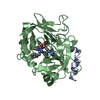 1shhS S: Starting model for refinement |
|---|---|
| Similar structure data |
- Links
Links
- Assembly
Assembly
| Deposited unit | 
| ||||||||
|---|---|---|---|---|---|---|---|---|---|
| 1 | 
| ||||||||
| 2 | 
| ||||||||
| Unit cell |
|
- Components
Components
| #1: Protein/peptide |  / Coagulation factor II / Activation peptide fragment 1 / Activation peptide fragment 2 / Thrombin ...Coagulation factor II / Activation peptide fragment 1 / Activation peptide fragment 2 / Thrombin light chain / Thrombin heavy chain / Coagulation factor II / Activation peptide fragment 1 / Activation peptide fragment 2 / Thrombin ...Coagulation factor II / Activation peptide fragment 1 / Activation peptide fragment 2 / Thrombin light chain / Thrombin heavy chainMass: 3647.075 Da / Num. of mol.: 2 Source method: isolated from a genetically manipulated source Source: (gene. exp.)   Homo sapiens (human) / Gene: F2 / Cell line (production host): BHK / Production host: Homo sapiens (human) / Gene: F2 / Cell line (production host): BHK / Production host:   Mesocricetus auratus (golden hamster) / References: UniProt: P00734, Mesocricetus auratus (golden hamster) / References: UniProt: P00734,  thrombin thrombin#2: Protein |  / Coagulation factor II / Activation peptide fragment 1 / Activation peptide fragment 2 / Thrombin ...Coagulation factor II / Activation peptide fragment 1 / Activation peptide fragment 2 / Thrombin light chain / Thrombin heavy chain / Coagulation factor II / Activation peptide fragment 1 / Activation peptide fragment 2 / Thrombin ...Coagulation factor II / Activation peptide fragment 1 / Activation peptide fragment 2 / Thrombin light chain / Thrombin heavy chainMass: 29779.234 Da / Num. of mol.: 2 / Mutation: D102N Source method: isolated from a genetically manipulated source Source: (gene. exp.)   Homo sapiens (human) / Gene: F2 / Cell line (production host): BHK / Production host: Homo sapiens (human) / Gene: F2 / Cell line (production host): BHK / Production host:   Mesocricetus auratus (golden hamster) / References: UniProt: P00734, Mesocricetus auratus (golden hamster) / References: UniProt: P00734,  thrombin thrombin#3: Protein/peptide | Mass: 952.128 Da / Num. of mol.: 2 Source method: isolated from a genetically manipulated source Source: (gene. exp.)   Homo sapiens (human) / Gene: F2RL3, PAR4 / Cell line (production host): BHK / Production host: Homo sapiens (human) / Gene: F2RL3, PAR4 / Cell line (production host): BHK / Production host:   Mesocricetus auratus (golden hamster) / References: UniProt: Q96RI0 Mesocricetus auratus (golden hamster) / References: UniProt: Q96RI0 |
|---|
-Experimental details
-Experiment
| Experiment | Method:  X-RAY DIFFRACTION / Number of used crystals: 1 X-RAY DIFFRACTION / Number of used crystals: 1 |
|---|
- Sample preparation
Sample preparation
| Crystal | Density Matthews: 2.51 Å3/Da / Density % sol: 50.98 % |
|---|---|
Crystal grow | Temperature: 295 K / Method: vapor diffusion, hanging drop / pH: 6.5 Details: 1.6 M tri-sodium citrate, pH 6.5, VAPOR DIFFUSION, HANGING DROP, temperature 295K |
-Data collection
| Diffraction | Mean temperature: 100 K | |||||||||||||||||||||||||||||||||||||||||||||||||
|---|---|---|---|---|---|---|---|---|---|---|---|---|---|---|---|---|---|---|---|---|---|---|---|---|---|---|---|---|---|---|---|---|---|---|---|---|---|---|---|---|---|---|---|---|---|---|---|---|---|---|
| Diffraction source | Source:  SYNCHROTRON / Site: SYNCHROTRON / Site:  APS APS  / Beamline: 14-BM-C / Wavelength: 0.9 Å / Beamline: 14-BM-C / Wavelength: 0.9 Å | |||||||||||||||||||||||||||||||||||||||||||||||||
| Detector | Type: ADSC QUANTUM 315 / Detector: CCD / Date: Feb 28, 2009 | |||||||||||||||||||||||||||||||||||||||||||||||||
| Radiation | Monochromator: APS 14-BM-C / Protocol: SINGLE WAVELENGTH / Monochromatic (M) / Laue (L): M / Scattering type: x-ray | |||||||||||||||||||||||||||||||||||||||||||||||||
| Radiation wavelength | Wavelength : 0.9 Å / Relative weight: 1 : 0.9 Å / Relative weight: 1 | |||||||||||||||||||||||||||||||||||||||||||||||||
| Reflection | Resolution: 2.8→40 Å / Num. all: 17276 / Num. obs: 16395 / % possible obs: 94.9 % / Observed criterion σ(F): -1 / Observed criterion σ(I): -1 / Redundancy: 6.5 % / Biso Wilson estimate: 50.3 Å2 / Rmerge(I) obs: 0.078 / Net I/σ(I): 19.6 | |||||||||||||||||||||||||||||||||||||||||||||||||
| Reflection shell |
|
- Processing
Processing
| Software |
| |||||||||||||||||||||||||
|---|---|---|---|---|---|---|---|---|---|---|---|---|---|---|---|---|---|---|---|---|---|---|---|---|---|---|
| Refinement | Method to determine structure : :  MOLECULAR REPLACEMENT MOLECULAR REPLACEMENTStarting model: PDB entry 1SHH Resolution: 2.8→40 Å / Rfactor Rfree error: 0.014 / Isotropic thermal model: RESTRAINED / Cross valid method: THROUGHOUT / σ(F): 0 / σ(I): 0 / Stereochemistry target values: Engh & Huber
| |||||||||||||||||||||||||
| Refine analyze |
| |||||||||||||||||||||||||
| Refinement step | Cycle: LAST / Resolution: 2.8→40 Å
| |||||||||||||||||||||||||
| Refine LS restraints |
| |||||||||||||||||||||||||
| LS refinement shell | Resolution: 2.8→2.98 Å / Rfactor Rfree error: 0.064 / Total num. of bins used: 6
|
 Movie
Movie Controller
Controller


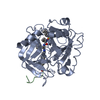

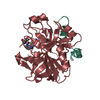
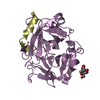



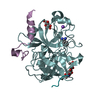
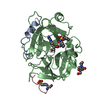
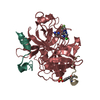
 PDBj
PDBj















